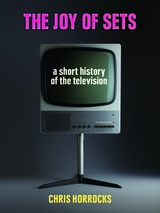6 books about Receivers and reception

The Joy of Sets
A Short History of the Television
Chris Horrocks
Reaktion Books, 2017
It is a modern activity, one of the primary ways we consume information and entertainment, something we’ll do over dinner, at a bar, or even standing on the street peering into a store window—watch TV. Many of us spend countless hours in front of the tube, and even those of us who have proudly eliminated it from our lives can probably still rattle off the names of today’s most popular shows. But for as crucial as television viewing is in modern culture, the television set itself, as a ubiquitous object in our environment, rarely captures our attention—turn one off and it seems to all but disappear. In this book, Chris Horrocks tells the story of the television set, exploring its contradictory presence in our lives as both a material object and a conveyor of illusory images.
Horrocks begins in the nineteenth century and television’s prehistory as a fantastic, futuristic concept. He follows the television’s journey from its strange roots in spiritualism, imperialism, and Victorian experiments in electro-magnetism to the contested accounts of its actual invention, looking at the work of engineering pioneers such as Philo Farnsworth and John Logie Baird. Unboxing sets all across the world, he details how it arrived as an essential consumer product and began to play an extraordinary role as a bridge between public and private life. Horrocks describes how the console and cabinet themselves expressed status and good taste and how their designs drew on cultural phenomena such as the space race and the avant-garde. He discusses how we have both loved it for what it can provide and reviled it as a sinister object literally controlling our thoughts, and he shows how it has figured in other cultural realms, such as the work of artists like Wolf Vostell and Nam June Paik. Finally, Horrock laments the death of the cathode ray tube and the emergence of the flat-screen, which has reduced the presence of the television as a significant material object. Altogether, The Joy of Sets brings this most elusive object into crystal-clear critical and historical focus.
Horrocks begins in the nineteenth century and television’s prehistory as a fantastic, futuristic concept. He follows the television’s journey from its strange roots in spiritualism, imperialism, and Victorian experiments in electro-magnetism to the contested accounts of its actual invention, looking at the work of engineering pioneers such as Philo Farnsworth and John Logie Baird. Unboxing sets all across the world, he details how it arrived as an essential consumer product and began to play an extraordinary role as a bridge between public and private life. Horrocks describes how the console and cabinet themselves expressed status and good taste and how their designs drew on cultural phenomena such as the space race and the avant-garde. He discusses how we have both loved it for what it can provide and reviled it as a sinister object literally controlling our thoughts, and he shows how it has figured in other cultural realms, such as the work of artists like Wolf Vostell and Nam June Paik. Finally, Horrock laments the death of the cathode ray tube and the emergence of the flat-screen, which has reduced the presence of the television as a significant material object. Altogether, The Joy of Sets brings this most elusive object into crystal-clear critical and historical focus.
[more]

Microwave and RF Design
A Systems Approach
Michael Steer
The Institution of Engineering and Technology, 2010

Microwave and RF Design
A Systems Approach, 2nd Edition
Michael Steer
The Institution of Engineering and Technology, 2013

Television
An international history of the formative years
R.W. Burns
The Institution of Engineering and Technology, 1998
From the first notions of 'seeing by electricity' in 1878, through the period of the first demonstration of rudimentary television in 1926 and up to 1940, when war brought the advance of the technology to a temporary halt, the development of television gathered about it a tremendous history. Following the discovery of the photo-conductive effect, numerous schemes for television were suggested but it was in the wake of Baird's early demonstrations that real industrial interest developed and the pace of progress increased. Much research and development work was undertaken in the UK, the US, Germany and France. By 1936 television technology had advanced to the point where high definition broadcasting was realistic.
[more]

The TVs of Tomorrow
How RCA’s Flat-Screen Dreams Led to the First LCDs
Benjamin Gross
University of Chicago Press, 2018
In 1968 a team of scientists and engineers from RCA announced the creation of a new form of electronic display that relied upon an obscure set of materials known as liquid crystals. At a time when televisions utilized bulky cathode ray tubes to produce an image, these researchers demonstrated how liquid crystals could electronically control the passage of light. One day, they predicted, liquid crystal displays would find a home in clocks, calculators—and maybe even a television that could hang on the wall.
Half a century later, RCA’s dreams have become a reality, and liquid crystals are the basis of a multibillion-dollar global industry. Yet the company responsible for producing the first LCDs was unable to capitalize upon its invention. In The TVs of Tomorrow, Benjamin Gross explains this contradiction by examining the history of flat-panel display research at RCA from the perspective of the chemists, physicists, electrical engineers, and technicians at the company’s central laboratory in Princeton, New Jersey.
Drawing upon laboratory notebooks, internal reports, and interviews with key participants, Gross reconstructs the development of the LCD and situates it alongside other efforts to create a thin, lightweight replacement for the television picture tube. He shows how RCA researchers mobilized their technical expertise to secure support for their projects. He also highlights the challenges associated with the commercialization of liquid crystals at RCA and Optel—the RCA spin-off that ultimately manufactured the first LCD wristwatch. The TVs of Tomorrow is a detailed portrait of American innovation during the Cold War, which confirms that success in the electronics industry hinges upon input from both the laboratory and the boardroom.
Half a century later, RCA’s dreams have become a reality, and liquid crystals are the basis of a multibillion-dollar global industry. Yet the company responsible for producing the first LCDs was unable to capitalize upon its invention. In The TVs of Tomorrow, Benjamin Gross explains this contradiction by examining the history of flat-panel display research at RCA from the perspective of the chemists, physicists, electrical engineers, and technicians at the company’s central laboratory in Princeton, New Jersey.
Drawing upon laboratory notebooks, internal reports, and interviews with key participants, Gross reconstructs the development of the LCD and situates it alongside other efforts to create a thin, lightweight replacement for the television picture tube. He shows how RCA researchers mobilized their technical expertise to secure support for their projects. He also highlights the challenges associated with the commercialization of liquid crystals at RCA and Optel—the RCA spin-off that ultimately manufactured the first LCD wristwatch. The TVs of Tomorrow is a detailed portrait of American innovation during the Cold War, which confirms that success in the electronics industry hinges upon input from both the laboratory and the boardroom.
[more]

Wireless Receiver Design for Digital Communications
Kevin McClaning
The Institution of Engineering and Technology, 2012
Practical lessons and approaches in radio receiver design for wireless communication systems are the hallmarks of Wireless Receiver Design for Digital Communications, 2nd Edition. Decades of experience 'at the bench' are collected within and the book acts as a virtual replacement for a mentor who teaches basic concepts from a practical perspective and has the war stories that help their 'apprentice' avoid the mistakes of the past.
[more]
READERS
Browse our collection.
PUBLISHERS
See BiblioVault's publisher services.
STUDENT SERVICES
Files for college accessibility offices.
UChicago Accessibility Resources
home | accessibility | search | about | contact us
BiblioVault ® 2001 - 2024
The University of Chicago Press









